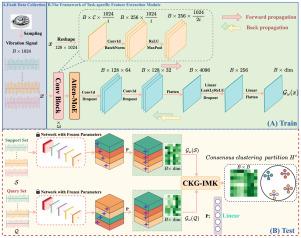分类知识指导下的轴承故障诊断
IF 7.5
2区 计算机科学
Q1 AUTOMATION & CONTROL SYSTEMS
Engineering Applications of Artificial Intelligence
Pub Date : 2024-10-28
DOI:10.1016/j.engappai.2024.109489
引用次数: 0
摘要
实时轴承故障诊断在维护精密工业系统的安全性和可靠性方面发挥着至关重要的作用。然而,由于故障样本收集困难和标注成本高昂,故障诊断中标注数据稀缺,这给从有限而复杂的监测信号中学习判别性故障特征带来了巨大挑战。少量学习(FSL)是一种从严重故障信号中提取并准确分类特征的有效方法。然而,数据稀缺和环境噪声等挑战极大地阻碍了现有 FSL 方法有效诊断初期故障的功效。这些局限性主要是由于当前的 FSL 方法没有充分考虑噪声环境下的类间相关性,从而限制了其将熟悉的特征推断到新类别的能力。因此,人们迫切需要一种能利用类间相关性来解决数据不足和环境复杂性等障碍的 FSL 方法,从而促进在少量数据的情况下对初期故障的诊断。本文提出了一种新颖的类别知识引导模型,专为少量多任务场景量身定制。通过利用基础类别的属性数据和新类别样本的相似性,我们的模型能有效地为未遇到的任务建立映射关系,从而显著增强其在早期故障诊断和多任务应用中的泛化能力。该模型可确保在未知运行条件下快速、精确地诊断 FSL 故障。利用凯斯西储大学轴承数据集和早期轻微故障牵引电机轴承数据集进行的比较分析表明,与领先的 FSL 和迁移学习方法相比,我们的模型具有卓越的性能。本文章由计算机程序翻译,如有差异,请以英文原文为准。

Category knowledge-guided few-shot bearing fault diagnosis
Real-time bearing fault diagnosis plays a vital role in maintaining the safety and reliability of sophisticated industrial systems. However, the scarcity of labeled data in fault diagnosis, due to the difficulty of collecting fault samples and the high cost of labeling, poses a significant challenge in learning discriminative fault features from limited and complex monitoring signals. Few-shot learning (FSL) emerges as a potent method for extracting and accurately classifying features from severe fault signals. Nonetheless, challenges such as data scarcity and environmental noise significantly impede the efficacy of existing FSL methods in diagnosing incipient faults effectively. These limitations are primarily due to the inadequate consideration of inter-class correlations within noisy contexts by current FSL strategies, which restricts their ability to extrapolate familiar features to new classes. Consequently, there is a pressing demand for an FSL approach that can exploit inter-class correlations to address the hurdles of data insufficiency and environmental complexities, thereby facilitating the diagnosis of incipient faults in few-shot settings. This paper proposes a novel category-knowledge-guided model tailored for few-shot multi-task scenarios. By leveraging attribute data from base categories and the similarities across new class samples, our model efficiently establishes mapping relations for unencountered tasks, significantly enhancing its generalization capabilities for early-stage fault diagnosis and multi-task applications. This model ensures swift and precise FSL fault diagnosis under uncharted operational conditions. Comparative analyses utilizing the Case Western Reserve University bearing dataset and the Early Mild Fault Traction Motor bearing dataset demonstrate our model’s superior performance against leading FSL and transfer learning approaches.
求助全文
通过发布文献求助,成功后即可免费获取论文全文。
去求助
来源期刊

Engineering Applications of Artificial Intelligence
工程技术-工程:电子与电气
CiteScore
9.60
自引率
10.00%
发文量
505
审稿时长
68 days
期刊介绍:
Artificial Intelligence (AI) is pivotal in driving the fourth industrial revolution, witnessing remarkable advancements across various machine learning methodologies. AI techniques have become indispensable tools for practicing engineers, enabling them to tackle previously insurmountable challenges. Engineering Applications of Artificial Intelligence serves as a global platform for the swift dissemination of research elucidating the practical application of AI methods across all engineering disciplines. Submitted papers are expected to present novel aspects of AI utilized in real-world engineering applications, validated using publicly available datasets to ensure the replicability of research outcomes. Join us in exploring the transformative potential of AI in engineering.
 求助内容:
求助内容: 应助结果提醒方式:
应助结果提醒方式:


